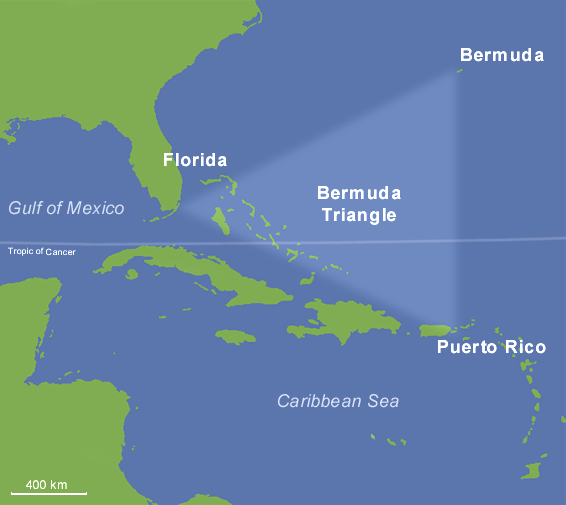
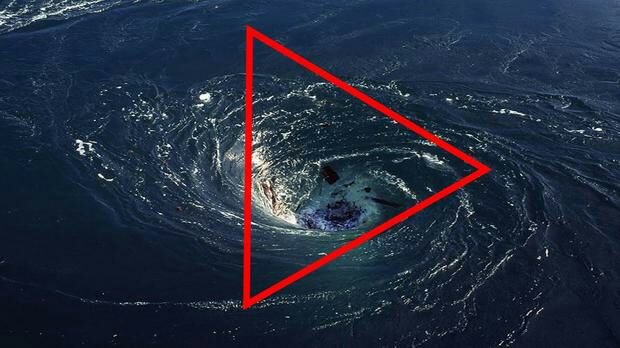
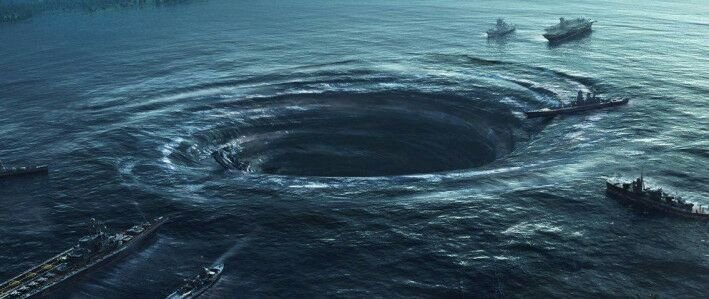
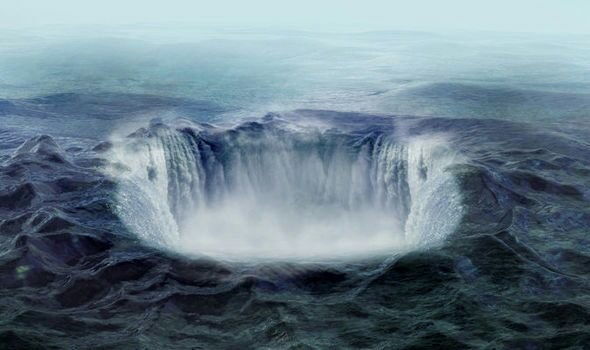
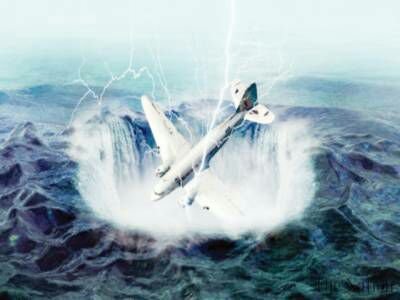

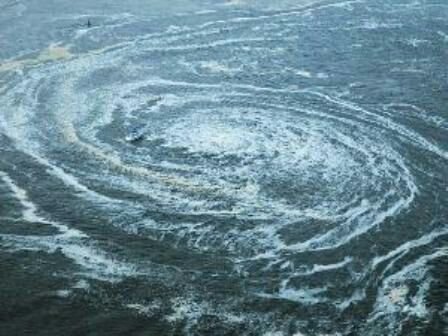
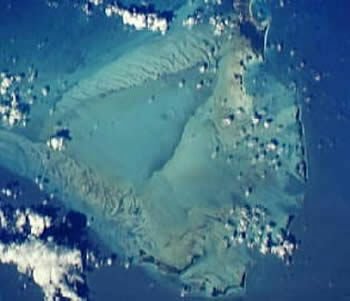
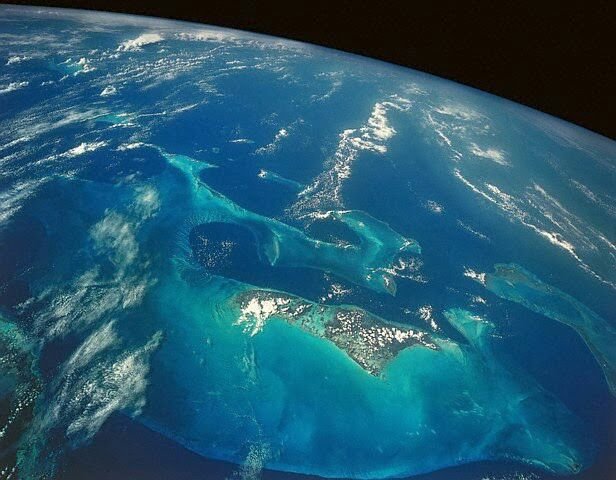
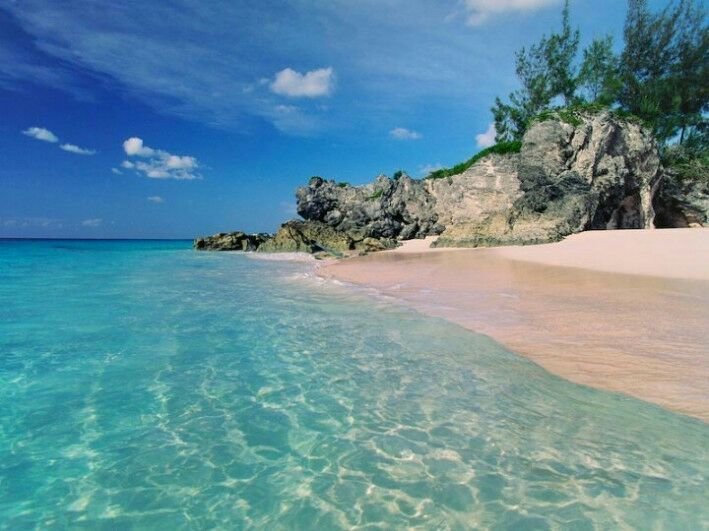
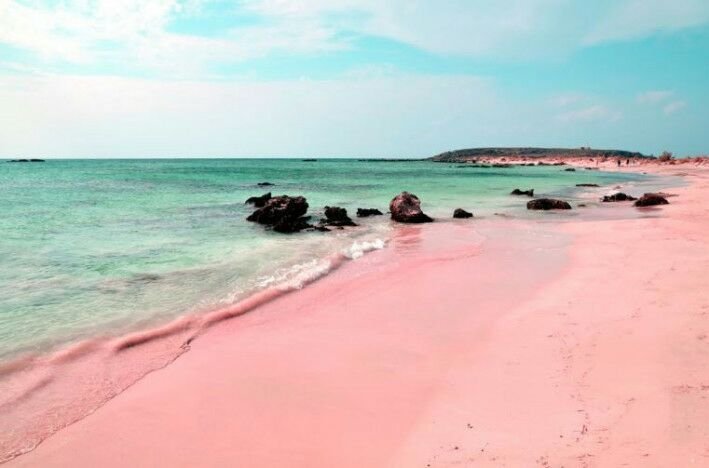
• The Bermuda Triangle, also known as the Devil’s Triangle
• is a loosely-defined region in the western part of the North Atlantic Ocean, where a number of aircraft and ships are said to have disappeared under mysterious circumstances. Most reputable sources dismiss the idea that there is any mystery. The vicinity of the Bermuda Triangle is amongst the most heavily traveled shipping lanes in the world, with ships frequently crossing through it for ports in the Americas, Europe and the Caribbean islands. Cruise ships and pleasure craft regularly sail through the region, and commercial and private aircraft routinely fly over it.Bermuda Triangle Devil’s Triangle One version of the Bermuda Trian
• Area Coordinates 25°N71°W/25°N 71°W Popular culture has attributed various disappearances to the paranormalor activity by extraterrestrial beings. Documented evidence indicates that a significant percentage of the incidents were spurious, inaccurately reported, or embellished by later authors.Triangle area In 1964,Vincent Gaddiswrote in the pulp magazine Argosyof the boundaries of the Bermuda Triangle,
• Giving it’s vertices as Miami,San Juan,Puerto Rico, and Bermuda. Subsequent writers did not necessarily follow this definition.[2]Some writers gave different boundaries and vertices to the triangle, with the total area varying from 1,300,000 to 3,900,000 km2(500,000 to 1,510,000 sq mi).
• Consequently, the determination of which accidents occurred inside the triangle depends on which writer reported them.[2]OriginsThe earliest suggestion of unusual disappearances in the Bermuda area appeared in a September 17, 1950, article published inThe Miami Herald(Associated Press) by Edward Van Winkle Jones.
• Two years later,Fatemagazine published "Sea Mystery at Our Back Door", a short article by George X. Sand covering the loss of several planes and ships, including the loss of flight 19, a group of five US Navy Grumman TBM Avengertorpedo bomberson a training mission. Sand's article was the first to lay out the now-familiar triangular area where the losses took place. Flight 19 alone would be covered again in the April 1962 issue ofAmerican Legionmagazine.[7]In it, authorAllan W. Eckertwrote that the flight leader had been heard saying, "We are entering white water, nothing seems right. We don't know where we are, the water is green, no white." He also wrote that officials at the Navy board of inquiry stated that the planes "flew off to Mars."
• Sand's articlewas the first to suggest a supernatural element tothe Flight 19 incident. In the February 1964 issue ofArgosy, Vincent Gaddis' article "The Deadly Bermuda Triangle" argued that Flight 19 and other disappearances were part of a pattern of strange events in the region.[1]The next year, Gaddis expanded this article into a book,InvisibleHorizons.
• Others would follow with their own works, elaborating on Gaddis' ideas: John Wallace Spencer (Limbo of the Lost, 1969, repr. 1973);
• Charles Berlitz(The Bermuda Triangle, 1974);
• Richard Winer(The Devil's Triangle, 1974), and many others, all keeping to some of the same supernatural elements outlined by Eckert.
• Criticism of the conceptLarry KuscheLawrence David Kusche, author ofThe Bermuda Triangle Mystery: Solved(1975)[14]argued that many claims of Gaddis and subsequent writers were often exaggerated, dubious or unverifiable. Kusche's research revealed a number of inaccuracies and inconsistencies between Berlitz's accounts and statements from eyewitnesses, participants, and others involved inthe initial incidents. Kusche noted cases where pertinent information went unreported, such as the disappearance of round-the-world yachtsmanDonald Crowhurst, which Berlitz had presented as a mystery, despite clear evidence to the contrary. Another example was the ore-carrier recounted by Berlitz as lost without trace three days out of anAtlanticport when it had been lost three days out of a port with the same name in thePacificOcean. Kusche also argued that a large percentage of the incidents that sparked allegations of the Triangle's mysterious influenceactually occurred well outside it. Often his research was simple: he would review period newspapers of the dates of reported incidents and find reports on possibly relevant events like unusual weather, that were never mentioned in the disappearance stories.Kusche concluded that:.The number of ships and aircraft reported missing in the area was not significantly greater, proportionally speaking, than in any other part of the ocean..In an area frequented bytropical cyclones, the number of disappearances that did occur were, for the most part, neither disproportionate, unlikely, nor mysterious..Furthermore, Berlitz and other writers would often fail to mention such storms or even represent the disappearance as having happened in calm conditions when meteorological records clearly contradict this..The numbers themselves had been exaggerated by sloppy research. A boat's disappearance, for example, would be reported, but its eventual (if belated) return to port may not have been..Some disappearances had, in fact, never happened. One plane crash was said to have taken place in 1937, offDaytona Beach, Florida, in front of hundreds of witnesses; a check of the local papers revealed nothing.[citation needed].The legend of the Bermuda Triangle is a manufactured mystery, perpetuated by writerswho either purposely or unknowingly made use of misconceptions, faulty reasoning, and sensationalism.
• In a 2013 study, theWorld Wide Fund for Natureidentified the world's 10 most dangerous waters for shipping, but the Bermuda Triangle was not among them.
• Further responsesWhen theUK Channel 4television programThe Bermuda Triangle(1992)[ was being producedby John Simmons of Geofilms for theEquinoxseries, the marine insurance marketLloyd's of Londonwas asked if an unusually large number of ships had sunk in the Bermuda Triangle area. Lloyd's determined that large numbers of ships had not sunk there.
• Lloyd's does not charge higher rates for passing through this area.United States Coast Guardrecords confirm their conclusion. In fact, the number of supposed disappearances is relatively insignificant considering the number of ships and aircraft that pass through on a regular basis. The Coast Guard is also officially skeptical of the Triangle, noting that they collect and publish, through their inquiries, much documentation contradicting many of the incidents written about by the Triangle authors. In one such incident involving the 1972 explosion and sinking of the tankerV. A. Fogg, the Coast Guard photographed the wreck and recovered several bodies, in contrast with one Triangle author's claim that all the bodies had vanished, with the exception of the captain, who was found sitting in his cabin at his desk, clutching a coffee cup.[10]In addition,V. A. Foggsank off the coast ofTexas, nowhere near the commonly accepted boundaries of the Triangle.TheNOVA/HorizonepisodeThe Case of the Bermuda Triangle, aired on June 27, 1976, was highly critical, stating that "When we've gone backto the original sources or the people involved, the mystery evaporates. Science does not have to answer questions about the Triangle because those questions are not valid in the first place ... Ships and planes behave in the Triangle the sameway they behave everywhere else in the world." Skeptical researchers, such as Ernest Taves and Barry Singer, have noted how mysteries and the paranormal are very popular and profitable. This has led to the production of vast amounts of material on topics such as the Bermuda Triangle. They were able to show that some of the pro-paranormal material is often misleading or inaccurate, but its producers continue to market it. Accordingly, they have claimed that the market is biased in favor of books, TV specials, and other media that support the Triangle mystery, and against well-researchedmaterial if it espouses a skeptical viewpoint.Explanation attemptsPersons accepting the Bermuda Triangle as a real phenomenon have offered a number of explanatory approaches.Paranormal explanationsTriangle writers have used a number of supernatural concepts to explain the events. One explanation pins the blame on leftover technology from the mythical lost continent ofAtlantis. Sometimes connected to the Atlantis story is the submerged rock formation known as theBimini Roadoff the island ofBiminiin the Bahamas, which is in the Triangle by some definitions. Followers of the purported psychicEdgar Caycetake his prediction that evidence of Atlantis would be found in 1968, as referring to the discovery of the Bimini Road. Believers describe the formation as a road, wall, or other structure, but the Bimini Road is of natural origin.
• Other writers attribute the events toUFOs. This idea was used bySteven Spielbergfor hisscience fiction filmClose Encounters of the ThirdKind, which features the lost Flight 19 aircrews asalien abductees.Charles Berlitz, author of various books on anomalous phenomena, lists several theories attributing the losses in the Triangle to anomalous or unexplained forces. A paranormal explanation in the 2005 three-part US-British-German science fiction miniseriesThe Triangle, says the triangle is a wormhole.Natural explanationsCompass variationsCompassproblems are one of the cited phrases in many Triangle incidents. While some have theorized that unusual local magnetic anomalies may exist in the area, such anomalies have not been found. Compasses have naturalmagnetic variationsin relation to themagnetic poles, a fact which navigators have known for centuries.Magnetic (compass) northandgeographic (true) northare exactly the same only for a small number of places – for example, as of 2000, in the United States, only those places on a line running fromWisconsinto theGulf of Mexico. But the public may not be as informed, and think there is something mysterious about a compass "changing" across an area as large as the Triangle, which it naturally will.[14]False-color image of the Gulf Stream flowing north through the western Atlantic Ocean. (NASA)Gulf StreamTheGulf Streamis a major surface current, primarily driven bythermohaline circulationthat originates in the Gulf of Mexico and then flows through theStraits of Floridainto the North Atlantic. In essence, it is a river within an ocean, and, like a river, it can and does carry floating objects. It has a maximum surface velocity of about 2 m/s (6.6 ft/s). A small plane making awater landingor a boat having engine trouble canbe carried away from its reported position by the current.Human errorOne of the most cited explanations in official inquiries as to the loss of any aircraft or vessel ishuman error. Human stubbornness may have caused businessman Harvey Conover to lose his sailing yacht,Revonoc, as he sailed into the teethof a storm south of Florida on January 1, 1958. Violent weatherHurricanes are powerful storms that form in tropical waters and have historically cost thousands of lives and caused billions of dollars in damage. The sinking ofFrancisco de Bobadilla's Spanish fleet in 1502 was the first recorded instance of a destructive hurricane. These stormshave in the past caused a number of incidents related to the Triangle.A powerfuldowndraft of cold airwas suspected to be a cause in the sinking ofPride of Baltimoreon May 14, 1986. The crew of the sunken vessel noted the wind suddenly shifted and increased velocity from 32 km/h (20 mph) to 97–145 km/h (60–90 mph). A National Hurricane Center satellite specialist, James Lushine, stated "duringvery unstable weather conditions the downburst of cold air from aloft can hit the surface like a bomb, exploding outward like a giant squall line of wind and water." A similar event occurred toConcordiain 2010, off the coast of Brazil. Scientists are currently investigating whether "hexagonal" clouds may be the source of these up-to-170 mph (270 km/h) "air bombs". Methane hydratesMain article:Methane clathrateWorldwide distribution of confirmed or inferred offshore gas hydrate-bearing sediments, 1996.Source:United States Geological SurveyAn explanation for some of the disappearances has focused on the presence of large fields ofmethanehydrates (a form of natural gas) on thecontinental shelves. Laboratory experiments carried out in Australia have proven that bubbles can, indeed, sink a scale model ship by decreasing the density of the water; any wreckage consequently rising to the surface would be rapidly dispersed by the Gulf Stream. It has been hypothesized that periodic methaneeruptions(sometimes called "mud volcanoes") may produce regions of frothy water that are no longer capable of providing adequatebuoyancyfor ships. If this were the case, such an area forming around a ship could cause it to sink very rapidly and without warning.Publications by theUSGSdescribe large stores ofundersea hydrates worldwide, including theBlakeRidgearea, off the coast of the southeastern United States. However, according to the USGS, no large releases of gas hydrates are believed to have occurred in the Bermuda Triangle for the past 15,000 years. Notable incidentsMain article:List of Bermuda Triangle incidentsEllen AustinEllen Austinsupposedly came across a derelict ship, placed on board aprize crew, and attempted to sail with it to New York in 1881. According to the stories, the derelict disappeared;others elaborating further that the derelict reappeared minus the prize crew, then disappeared again with a second prize crew on board. A check from Lloyd's of London records proved the existence ofMeta, built in 1854, and that in 1880,Metawas renamedEllen Austin. There are no casualty listings for this vessel, or any vessel at that time, that would suggest a large number of missing men were placed on board a derelict that later disappeared. USSCyclopsMain article:USS Cyclops (AC-4)The incident resulting in the single largest loss oflife in the history of the US Navy not related to combat occurred when the collierCyclops, carrying a full load ofmanganese oreand with one engine out of action, went missing without a trace with a crew of 309 sometime after March 4, 1918, after departing the island ofBarbados. Although there is no strong evidence for any single theory, many independent theories exist, some blaming storms, some capsizing, and somesuggesting thatwartime enemy activitywas to blame for the loss. In addition, two ofCyclops's sister ships,ProteusandNereuswere subsequently lost in the North Atlantic duringWorld War II. Both ships were transporting heavy loads of metallic ore similar to that which was loaded onCyclopsduring her fatal voyage. In all three cases structural failure due to overloading with a much denser cargo than designed is considered the most likely cause of sinking.Carroll A. DeeringMain article:Carroll A. DeeringSchoonerCarroll A. Deering, as seen from theCape Lookoutlightvesselon January 29, 1921,two days before she was found deserted inNorth Carolina. (US Coast Guard)A five-masted schooner built in 1919,Carroll A. Deeringwas found hard aground and abandoned atDiamond Shoals, nearCape Hatteras,North Carolina, on January 31, 1921. Rumors and more at the time indicatedDeeringwas a victim of piracy, possibly connected with the illegalrum-runningtrade duringProhibition, and possibly involving another ship,Hewitt, which disappeared at roughly the same time. Just hourslater, an unknown steamer sailed near the lightship along the track ofDeering, and ignored all signals from the lightship. It is speculated thatHewittmay have been this mystery ship, and possibly involved inDeering's crew disappearance.
• Flight 19Main article:Flight 19US Navy Avengers, similar to those of Flight 19Flight 19 was a training flight of fiveTBM Avengertorpedo bombers that disappeared on December 5, 1945, while over the Atlantic. The squadron's flight plan was scheduled to take them due east fromFort Lauderdalefor 141 mi (227 km), north for 73 mi (117 km), and then backover a final 140-mile (230-kilometre) leg to complete the exercise. The flight never returned to base. The disappearance is attributed by Navy investigators to navigational error leading to the aircraft running out of fuel.One of the search and rescue aircraft deployed tolook for them, aPBM Marinerwith a 13-man crew,also disappeared. A tanker off the coast of Florida reported seeing an explosion and observing a widespread oil slick when fruitlessly searching for survivors. The weather was becoming stormy by the end of the incident.
• According to contemporaneous sources the Mariner had a history of explosions due to vapourleaks when heavily loaded with fuel, as it might have been for a potentially long search-and-rescue operation.Star TigerandStar ArielMain articles:BSAA Star Tiger disappearanceandBSAA Star Ariel disappearanceG-AHNPStar Tigerdisappeared on January 30, 1948, on a flight from theAzoresto Bermuda;G-AGREStar Arieldisappeared on January 17, 1949, on a flight from Bermuda toKingston, Jamaica. Both wereAvroTudor IVpassenger aircraft operated byBritish South American Airways. Both planes were operating at the very limits of their range and the slightest error orfault in the equipment could keep them from reaching the small island. Douglas DC-3Main article:1948 Airborne Transport DC-3 (DST) disappearanceOn December 28, 1948, aDouglas DC-3aircraft, numberNC16002, disappeared while on a flight from San Juan, Puerto Rico, to Miami. No trace ofthe aircraft, or the 32 people on board, was ever found. A Civil Aeronautics Board investigation found there was insufficient information availableon which to determine probable cause of the disappearance. Connemara IVA pleasure yacht was found adrift in the Atlantic south of Bermuda on September 26, 1955; it is usually stated in the stories (Berlitz, Winer) that the crew vanished while the yacht survived being at sea during three hurricanes. The1955 Atlantic hurricane seasonshowsHurricane Ionepassing nearby between 14 and 18 September, with Bermuda being affected by winds of almost gale force. In his second book on the Bermuda Triangle, Winer quoted froma letter he had received from Mr J.E. Challenor of Barbados:[46]On the morning of September 22,Connemara IVwas lying to a heavy mooring in the openroadsteadofCarlisle Bay. Because of the approaching hurricane, the owner strengthened the mooring ropes and put out two additional anchors. There was little else he could do, asthe exposed mooring was the only available anchorage. ... In Carlisle Bay, the sea in the wake ofHurricane Janetwas awe-inspiring and dangerous. The owner ofConnemara IVobserved that she had disappeared. An investigation revealed that she had dragged her moorings and gone to sea.KC-135 StratotankersOn August 28, 1963, a pair ofUS Air ForceKC-135Stratotankeraircraft collided and crashed into theAtlantic. The Triangle version (Winer, Berlitz, Gaddis) of this story states that while the two aircraft did collide and crash, there were two distinct crash sites, separated by over 160 miles (260 km) of water. However, Kusche's research showed that the unclassified version of the Air Force investigation report stated that the debris field defining the second "crash site" was examined by a search and rescue ship, and found to be a mass of seaweed and driftwood tangled in an old buoy.